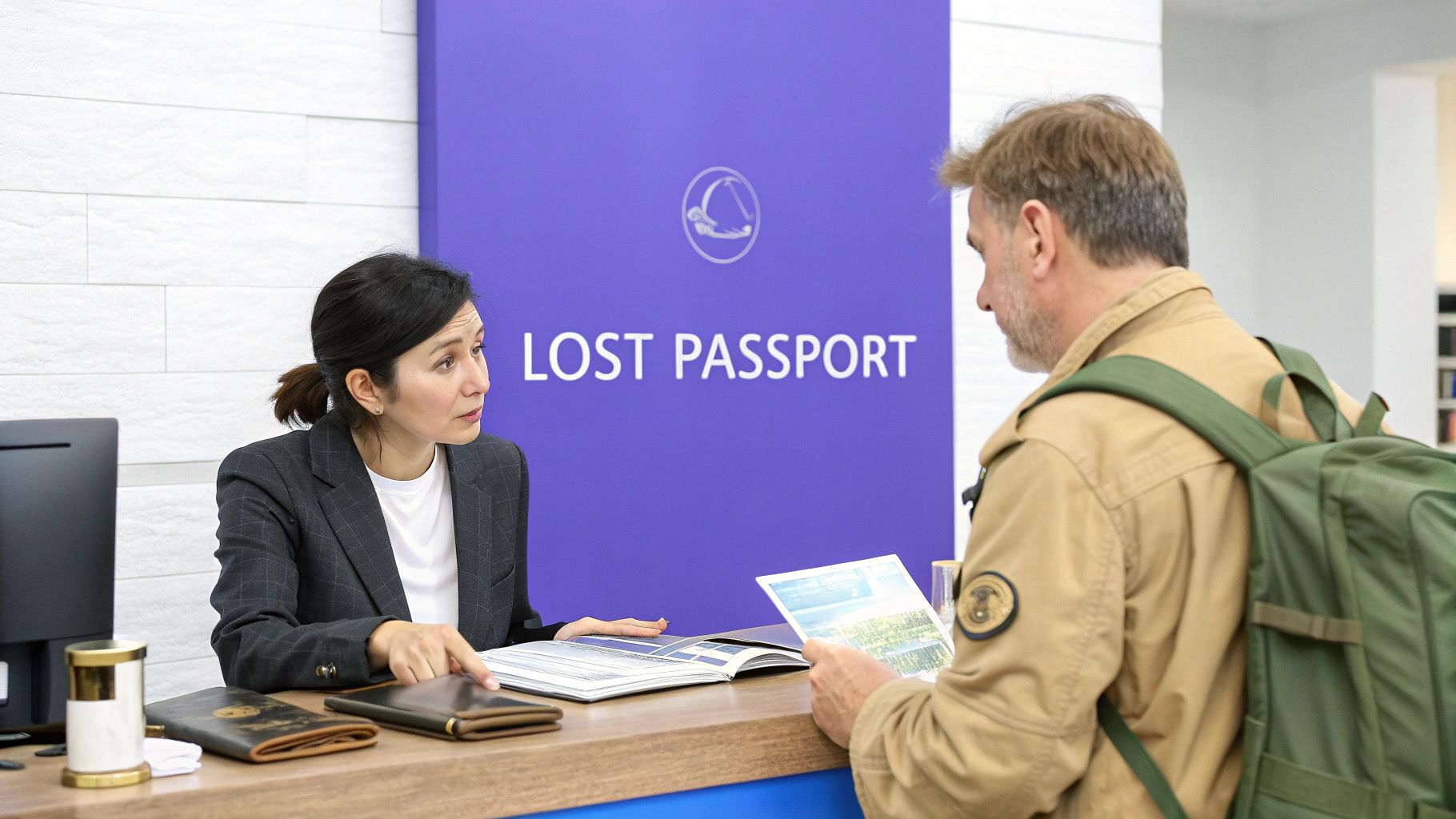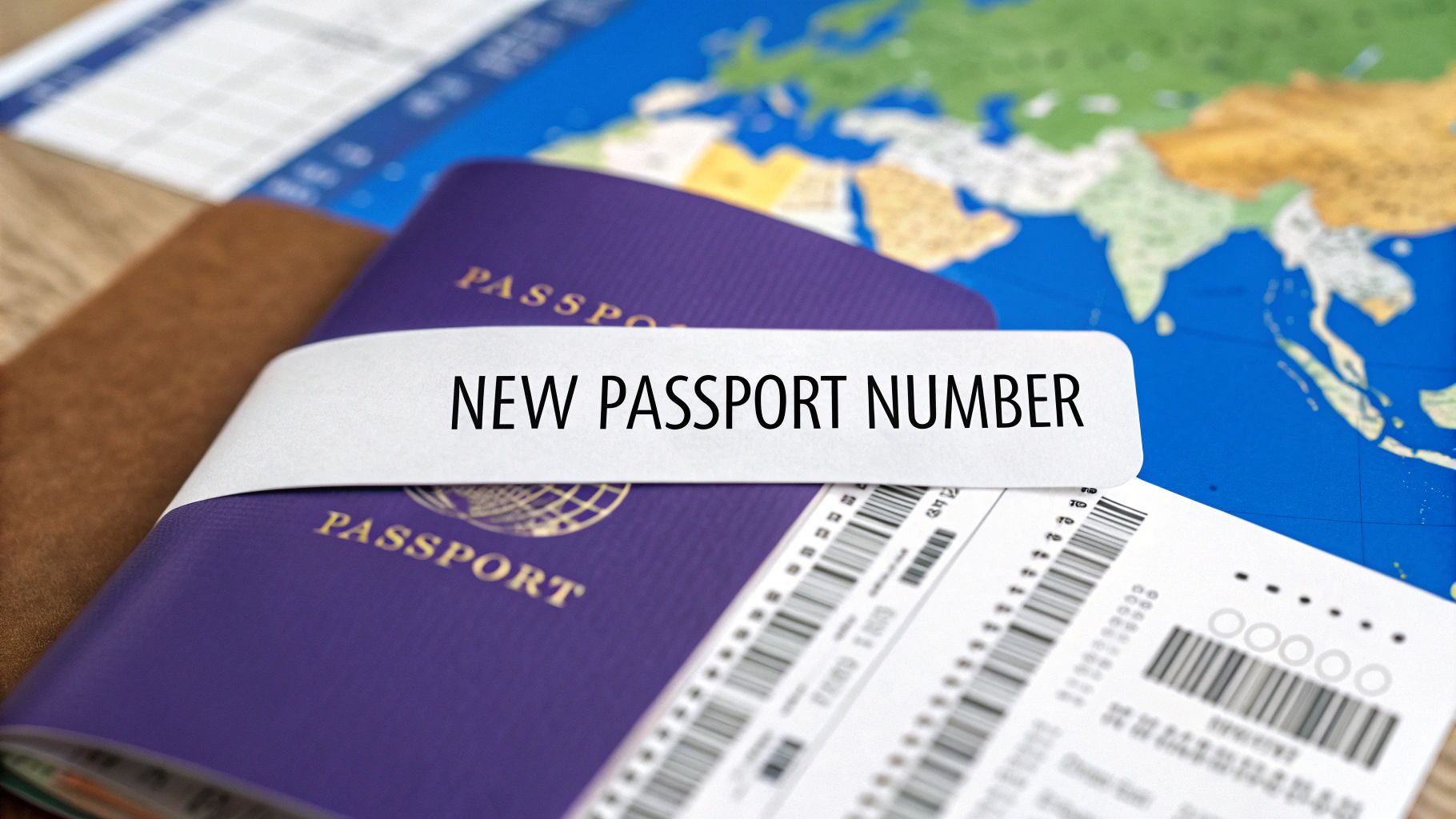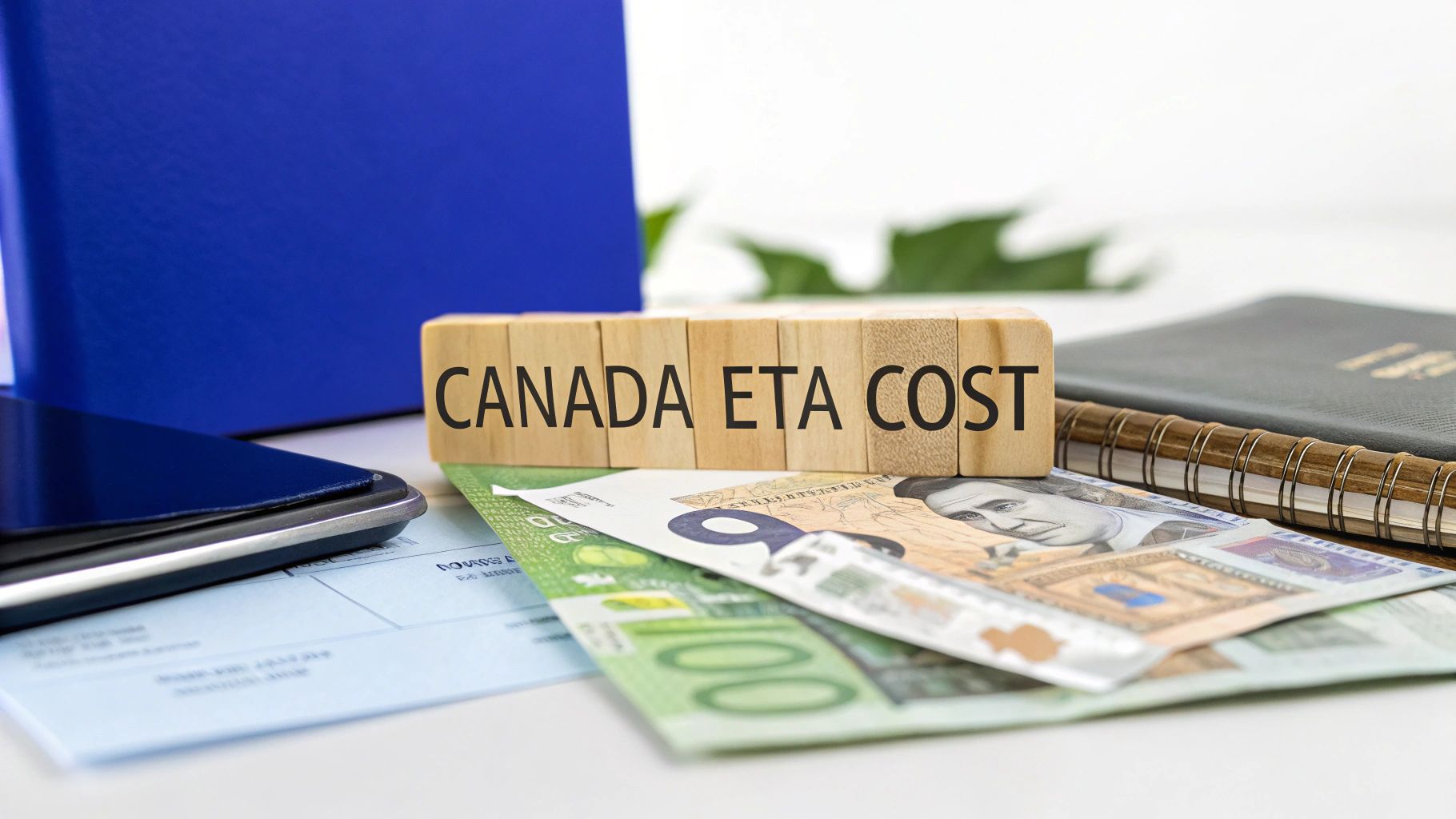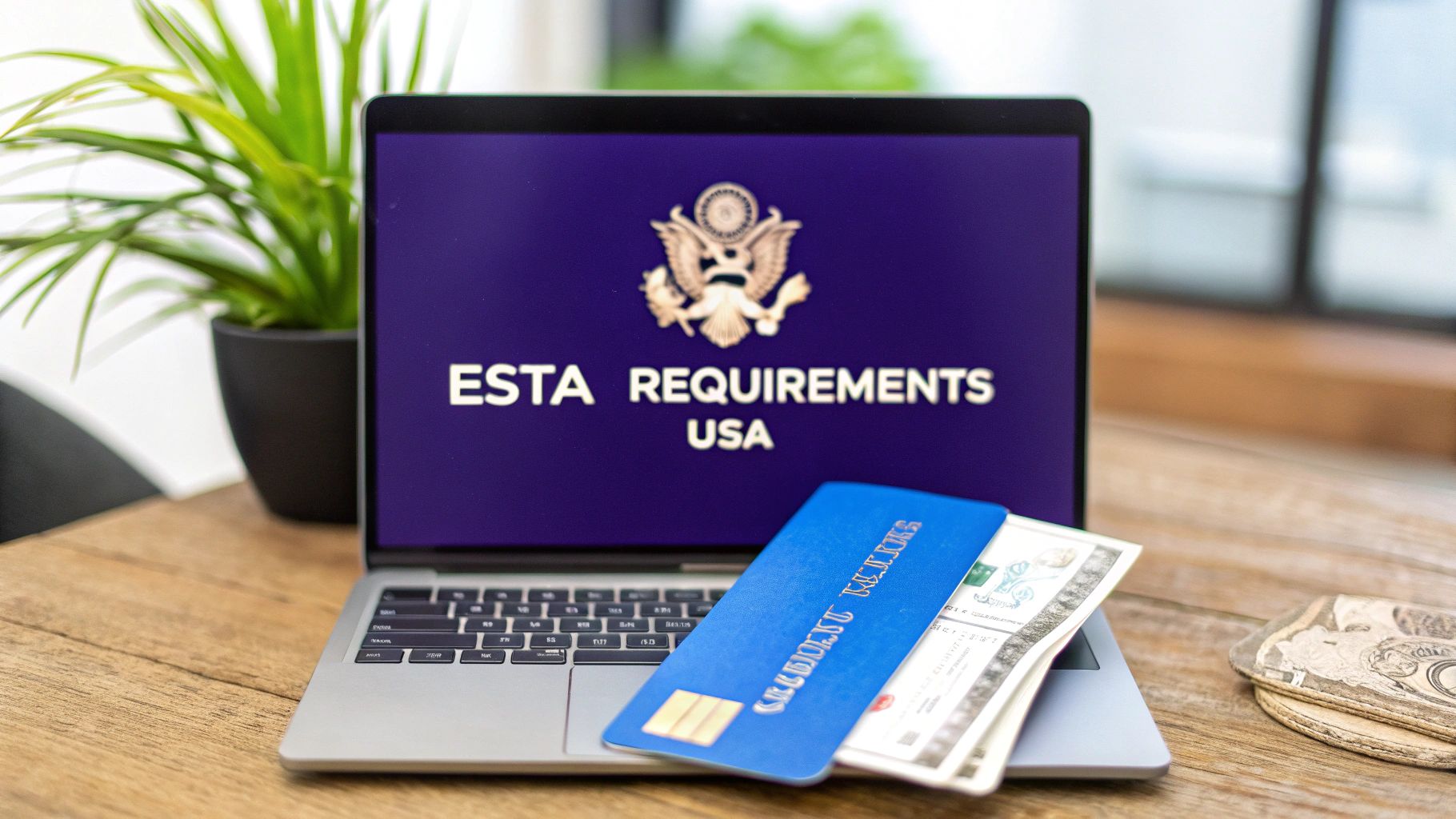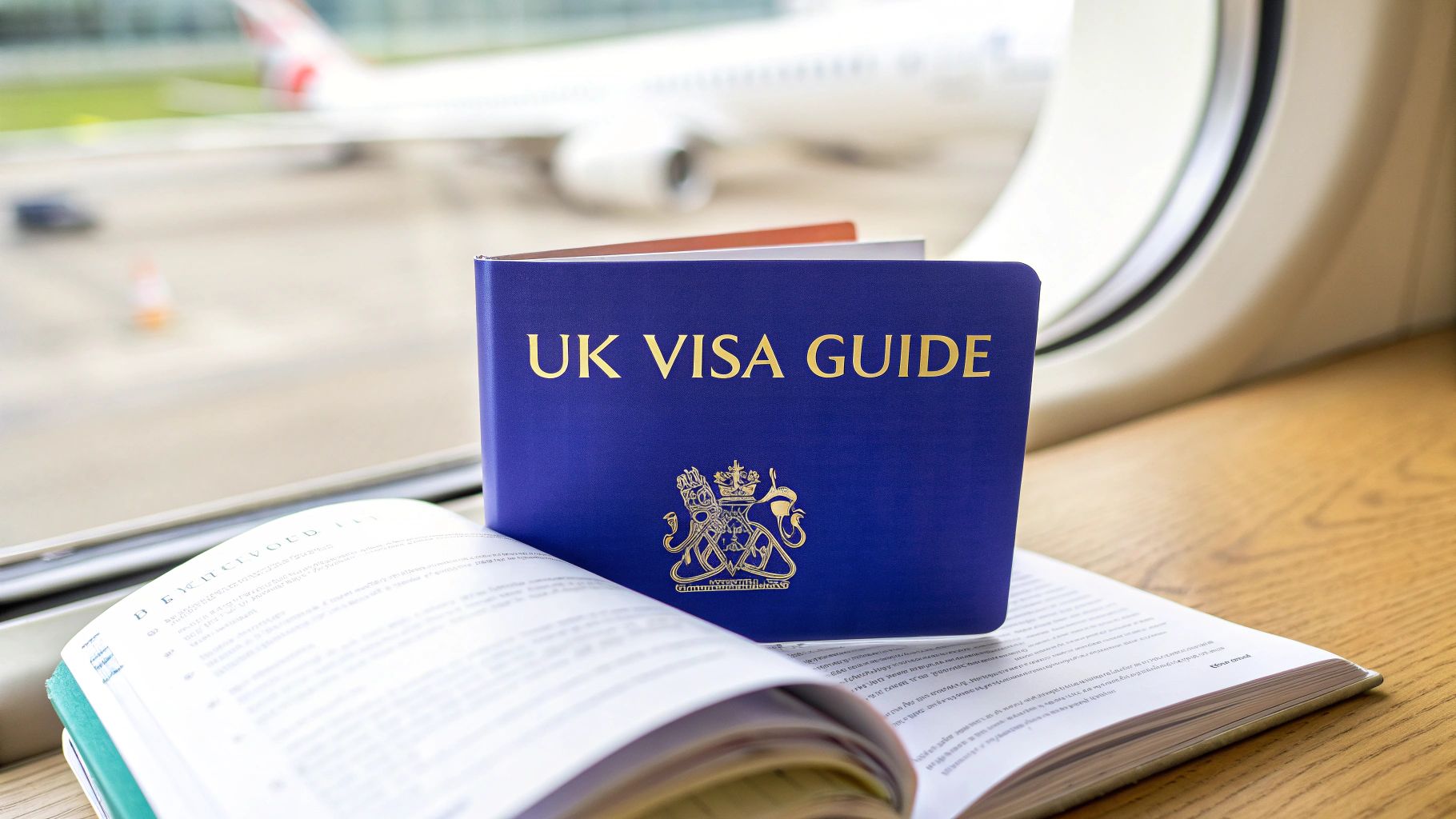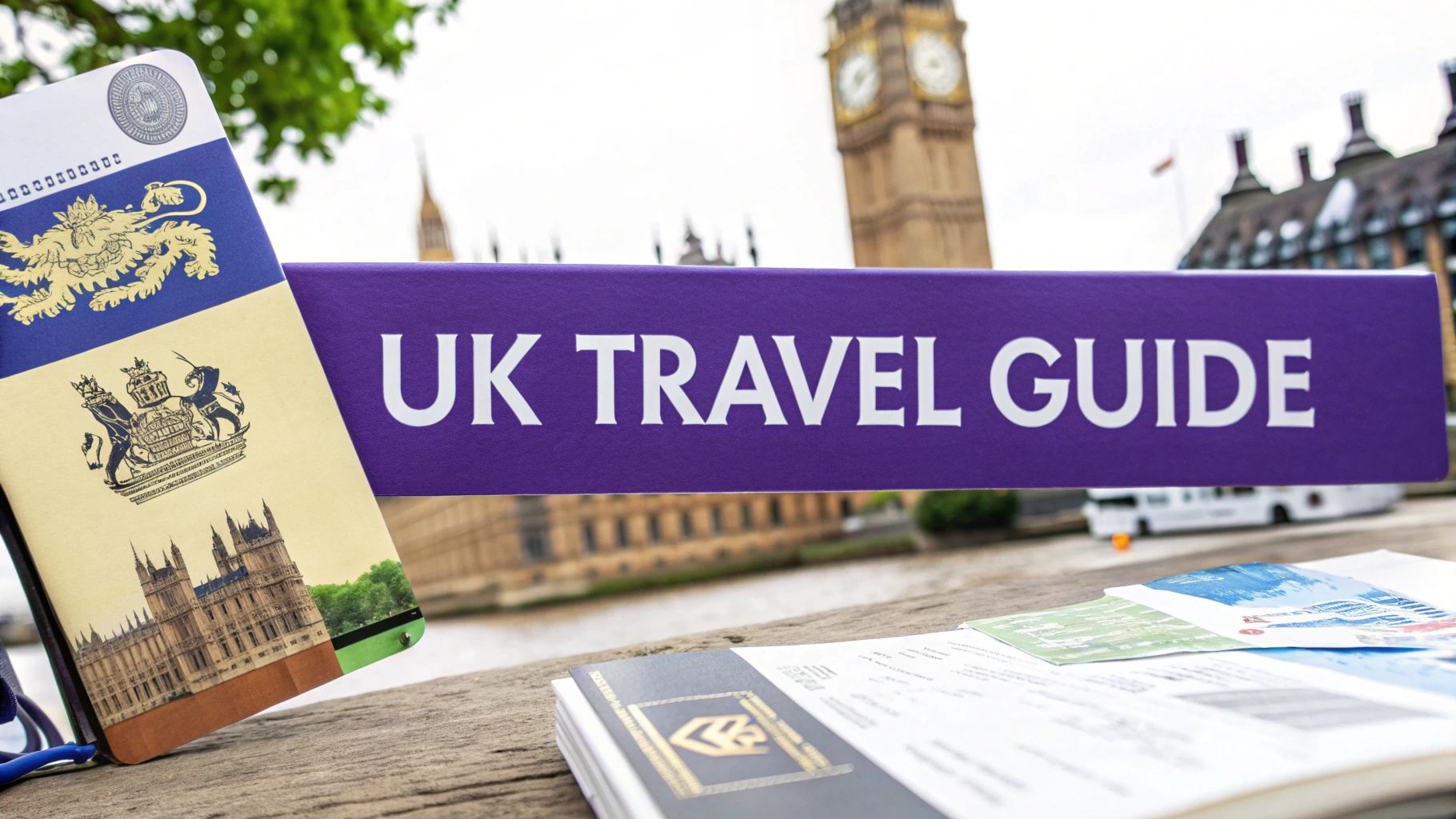
Documents Needed for UK Visitor Visa: Essential Checklist
When you're putting together your UK visitor visa application, the paperwork can feel a bit overwhelming. But think of it this way: each document is a piece of a puzzle that shows the Home Office who you are, why you're visiting, and why you'll head back home when you say you will.
Getting this part right is everything. A valid passport, proof you can fund your trip, your travel plans, and solid evidence of ties to your home country are the absolute essentials. Nail this, and you're already on the right track.
Your UK Visitor Visa Document Checklist
The key is to understand why each document is requested. It’s not just about ticking boxes. The Home Office needs to see a clear, consistent story. If one piece is missing or doesn't line up, it can cause delays or even a flat-out rejection. That’s why a solid checklist is your best friend.
To make it simple, let's break down the required documents into three core pillars: Identity, Financials, and your Travel Itinerary.
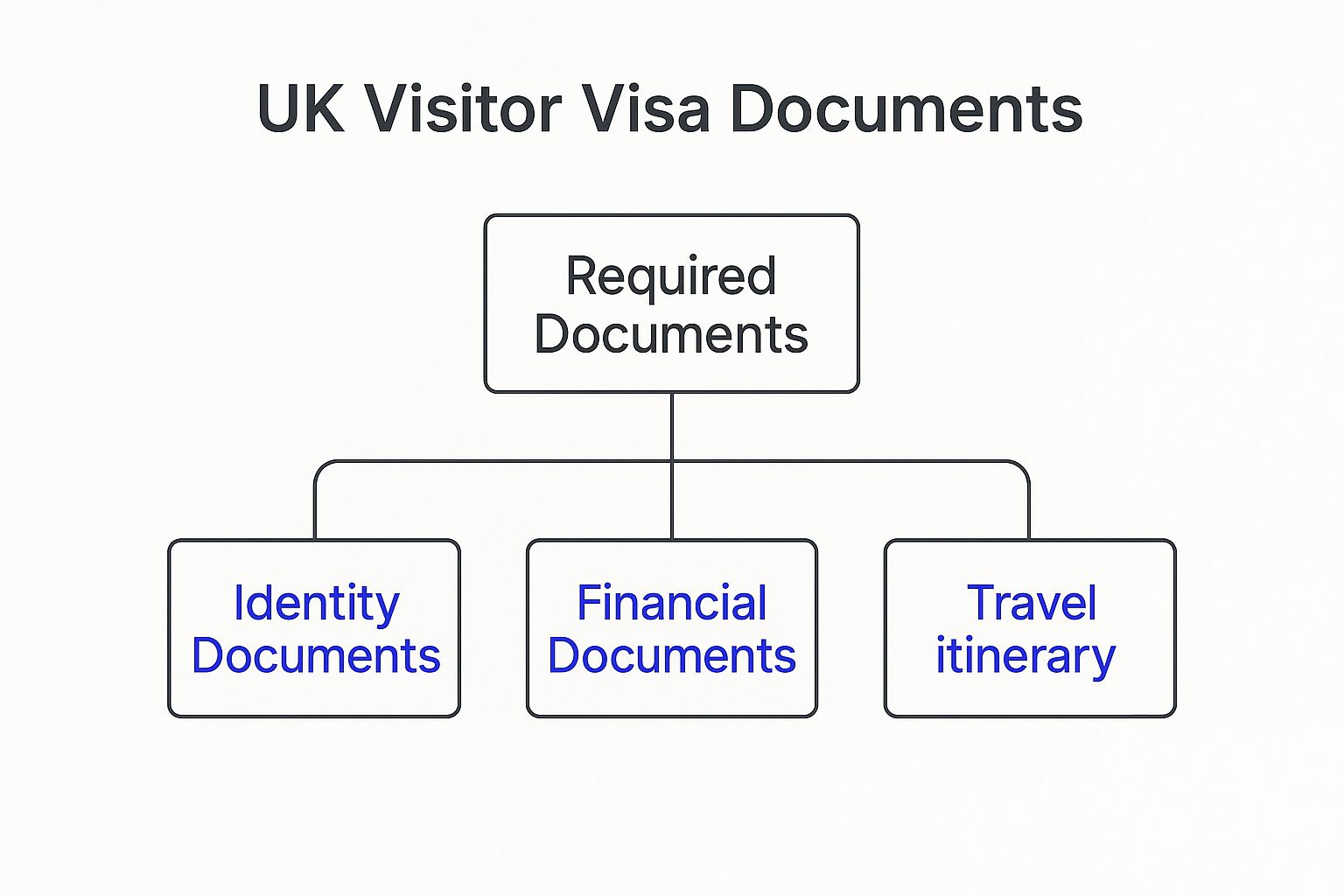
As you can see, every piece of evidence you provide supports one of these three fundamental areas, building a strong and trustworthy case for your visit.
To give you a clearer picture, here’s a quick summary of the main documents you'll need to gather.
Summary of Required Documents
| Document Type | Purpose | Sample Proof |
|---|---|---|
| Passport | To verify your identity and nationality. | Your current, valid passport with at least one blank page. |
| Financial Proof | To show you can afford your trip without working or needing public funds. | Bank statements for the last 6 months, payslips, or a letter from a sponsor. |
| Travel Itinerary | To outline your travel plans and the purpose of your visit. | Flight reservations, hotel bookings, a day-by-day plan of activities. |
| Ties to Home Country | To prove you have strong reasons to return home after your visit. | A letter from your employer, proof of property ownership, or evidence of family commitments. |
This table covers the essentials, but the official government checklist will give you the full, detailed breakdown. For a deeper dive into the specifics, you might also want to check out our complete guide on general UK visa requirements.
It’s worth noting that many travelers from visa-exempt countries can now use the UK's simpler Electronic Travel Authorisation (ETA) system instead of a full visa. To simplify your UK ETA application and increase your chances of approval, consider using a third-party application assistance provider like AssistEntry—their experts guide you through the entire process, starting from just $79, which includes the government fee.
Why Every Document Tells a Story
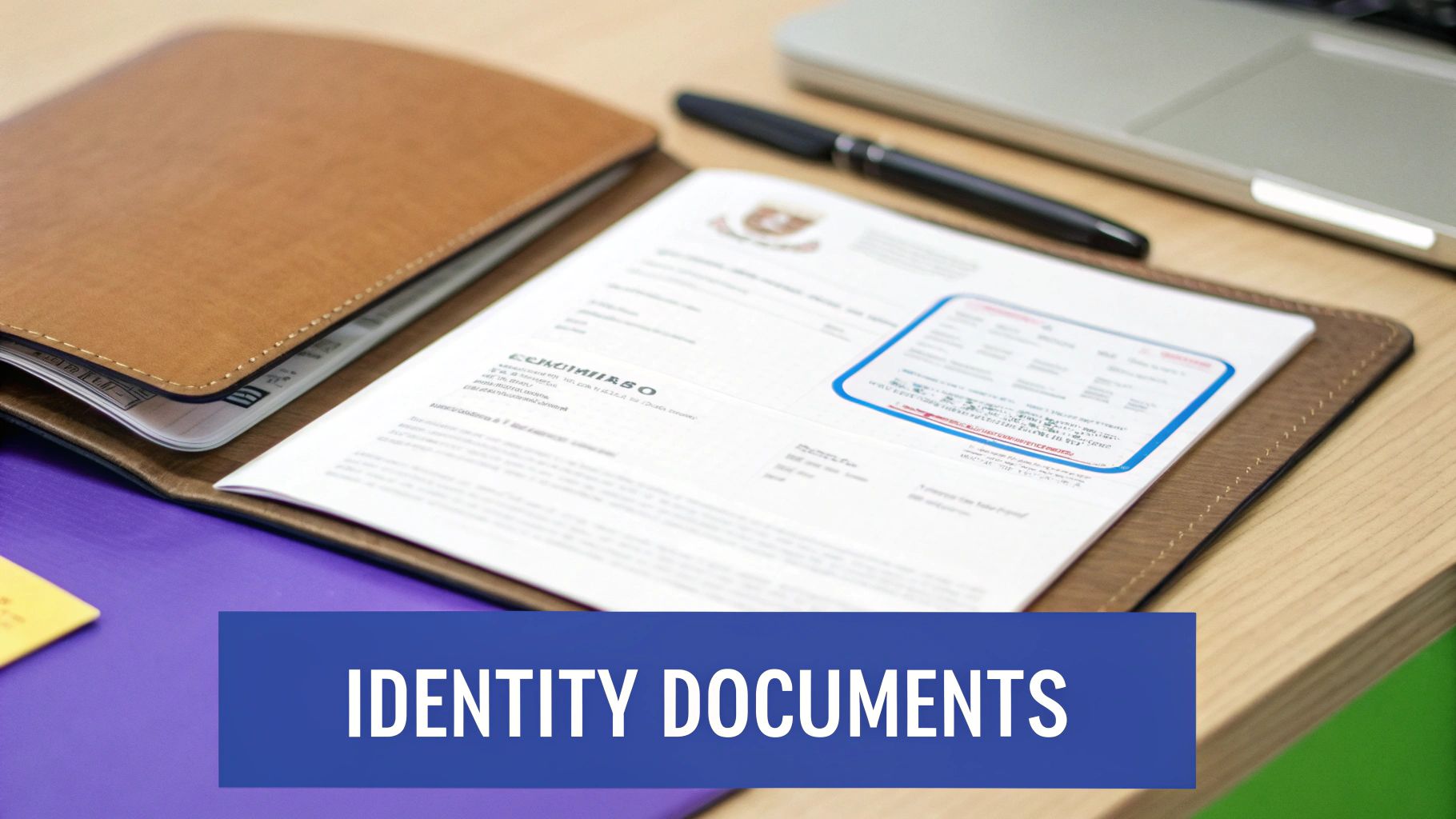
Think of your visa application less like a checklist and more like a story. You're not just submitting paperwork; you're building a convincing case for yourself. UK immigration officers are trained to find a clear, consistent narrative that answers three fundamental questions: Who are you? Why are you coming to the UK? And will you leave when your visit is over?
Every single document you provide is a piece of that story. Your bank statements, for instance, aren't just a list of transactions. They're proof of your financial stability, showing you can afford your trip without needing to work or rely on public funds. That letter from your employer? It’s a crucial chapter confirming you have a job to return to, which makes your promise to leave the UK much more believable. When all these pieces fit together seamlessly, you present a complete and credible picture of a genuine visitor.
Building a Trustworthy Narrative
Your main goal is to build a story that leaves no room for doubt or suspicion. Every document needs to back up the others, creating a narrative that’s both coherent and credible. For example, the dates on your travel itinerary must align with the leave approved in your employer’s letter, and the funds in your bank account should comfortably cover your planned expenses.
Inconsistencies are immediate red flags. If you say you’re visiting as a tourist but have no hotel bookings or a rough plan of activities, it undermines your entire story. With UK immigration policies constantly evolving, getting the details right is more important than ever. When you understand the why behind each required document, you can anticipate what the decision-maker is looking for and present your case far more effectively.
Recent statistics from the UK Home Office show just how much documentation matters. After stricter financial proof requirements were introduced in April 2024, the number of family visa applications plunged from 12,700 to only 5,100 by June 2024. This isn't a coincidence; it shows the government uses document requirements as a primary tool to manage immigration. You can dig deeper into these trends in the official government report.
The best applications tell a clear, simple story. They demonstrate that the applicant is a genuine visitor who has the means to support themselves and every intention of returning home.
Putting this all together can feel complicated, but getting the story right is what separates a successful application from a refusal. To get a better sense of the big picture, take a look at our detailed guide on the UK visa application process. Understanding the full context will help you build a much stronger, more persuasive application.
Gathering Your Core Application Documents

Alright, now that you know why each document is so important, let's get into the nitty-gritty of gathering your core paperwork. Think of this as the foundation of your entire visa application. Getting these essentials right from the get-go is the best way to avoid those frustrating delays—or even an outright rejection.
First up is your most critical piece of ID: your valid passport or travel document. Before you do anything else, check its expiry date. It must be valid for your entire planned stay in the UK. Just as important, flip through the pages and make sure you have at least one completely blank page for the visa stamp. An expired passport or one that’s all filled up is a non-starter.
Proving You Can Afford Your Trip
This is where Home Office officials really pay attention. You need to show them, in black and white, that you have the money to cover your entire trip. This includes your flights, accommodation, food, and a buffer for any surprises, all without needing to work or ask for public funds in the UK.
The key here is to provide clear, consistent proof. These are the go-to documents:
- Bank Statements: You’ll need the last six months of statements. What they’re looking for is a stable income and enough savings to comfortably fund your visit. A word of caution: avoid making large, unusual cash deposits right before you apply. It’s a major red flag for visa officers.
- Payslips: To back up your bank statements, include your payslips from the same six-month period. This connects the dots and shows where your income is coming from.
- A Letter from Your Employer: This simple document is incredibly powerful. It should confirm your job title, salary, and—crucially—that your time off has been approved. It’s solid proof that you have a job to return to.
When you put these three documents together, they create a clear picture of a financially responsible person with every intention of returning home after their visit.
Explaining Your Travel Plans
Next, you need to lay out what you plan to do in the UK. This helps the immigration officer understand your visit is genuine and well-planned. Your travel itinerary doesn't have to be set in stone, but it should be detailed and realistic.
A statement of purpose is a must. This is just a short, honest letter explaining why you want to visit the UK. Are you coming for a holiday, to see family, or for a business meeting? Be direct, and make sure what you write matches the evidence you're providing. If you’re not sure where to start, our guide on how to apply for a visa to England has some great tips to get you going.
The UK's immigration rules are getting stricter. For instance, in 2024, the government increased the minimum income for family-related visas to £29,000. While this doesn't directly affect visitor visas, it shows a clear trend: they are serious about financial proof. You can dig deeper into these changes in this detailed Home Office report analysis.
Bolster Your Application with Supporting Proof
Think of the required documents as the foundation of your application. But to really make your case undeniable, you’ll want to add supporting proof. While not always mandatory, these extra documents are your chance to tell a complete story and prove your intention to return home, leaving no doubt in the visa officer's mind.
One of the most powerful pieces of evidence you can provide is an official letter from your employer. It should confirm your job title, salary, and start date. Most importantly, it needs to state that your leave for the trip has been approved. This single document speaks volumes about your professional ties to your home country.
Another great way to show you have deep-rooted connections is by proving you own significant assets, like property deeds or vehicle ownership documents. Things you wouldn't just leave behind.
Proving Your Ties and Special Circumstances
The strongest applications are tailored to your personal situation. Each piece of evidence should add another layer of credibility and directly address the key concerns of a visa officer.
- Invitation Letter: If you’re staying with a friend or family in the UK, a letter of invitation from them is essential. It should confirm they know you, where you’ll be staying, and for how long. Pro tip: including a copy of their passport or residence permit adds a ton of weight.
- Previous Travel History: Have you traveled before and followed the rules? Show it off! Submitting copies of old visas from countries like the US, Canada, or Schengen states proves you have a history of complying with immigration laws.
- Tuberculosis (TB) Test Certificate: This one is mandatory if you are from certain countries. Don't guess—always check the official UK government list to see if you need to get a TB test certificate from an approved clinic.
The UK's documentation requirements have gotten more detailed over the years, all in an effort to improve security and manage immigration effectively. Since the early 2010s, the process has demanded more robust evidence of things like travel history, leading up to the standard use of biometrics by 2024. These changes highlight just how critical it is to provide thorough and compelling proof. You can get a deeper look at the strategy behind these policies by reviewing insights from this government report.
For many travelers, there's a much simpler path: the UK Electronic Travel Authorisation (ETA). To make your UK ETA application straightforward and boost your approval chances, consider using AssistEntry. As a trusted third-party application assistance provider, their experts guide you through the whole process. With full verification and error-checking services, they help make sure your application is right the first time, increasing your chances of approval.
Presenting Your Documents for Success
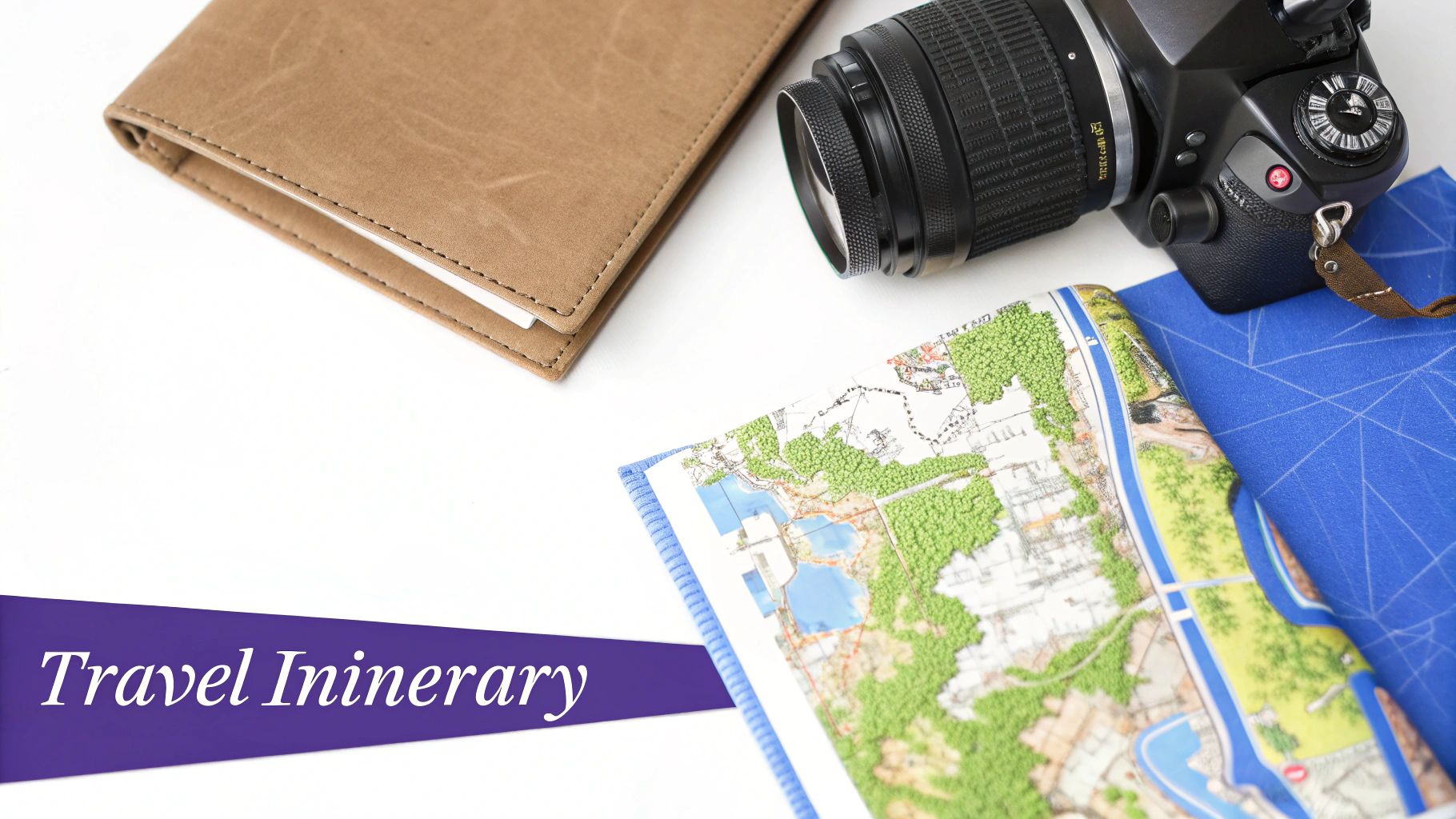
Simply having the right documents isn't enough—how you present them can make or break your application. A messy, disorganized submission just creates more work for the visa officer and, frankly, makes a poor first impression. Your goal is to hand over a professional, easy-to-review package that lets them tick the boxes and confirm you’re eligible without a headache.
Think of it like this: you wouldn't show up to a business meeting and just dump a stack of loose papers on the table. You'd organize them, label them, and present them in a logical order. The same exact principle applies here. A clean, well-organized file shows you're a serious and diligent applicant.
Organizing and Labeling Your Files
Before you even think about uploading anything, you need a system. With most applications now submitted online, getting your digital files in order is absolutely key. A simple but effective method will prevent confusion and ensure you don't accidentally miss something critical.
Here’s how to create a polished digital submission:
- Scan Clearly: Use a good scanner to create clean, legible PDF copies of every single document. Make sure there are no blurry spots, weird shadows, or cut-off corners.
- Label Everything: This is a big one. Name each file so it's instantly recognizable. Instead of a generic "Scan1.pdf," use something descriptive like "John-Smith-Passport.pdf" or "John-Smith-Bank-Statement-Jan-2025.pdf."
- Check Expiration Dates: Go through all your documents—especially your passport and any official letters—and double-check that they are valid and won't expire during your planned trip. An expired document is an instant red flag.
- Review for Signatures: Make sure every document that needs a signature has one. A missing signature on an employment letter or an invitation can render it useless.
Taking a few extra minutes to do this shows you’re thorough and makes the visa officer's job much easier. That can only work in your favor.
Translating Non-English Documents
If any of your documents are not in English or Welsh, you absolutely must provide a certified translation. This is a non-negotiable rule from the UK Home Office. A quick translation from a friend or a tool like Google Translate will not cut it.
Your translation must be done by a professional translator or translation company. It needs to include a signed statement confirming it's an accurate translation of the original, along with the date and the translator's contact details.
Failing to meet this standard is a common reason for applications to be delayed or even flat-out refused. It’s a small detail that carries a ton of weight.
For more tips on getting the details right, check out our guide to the UK ETA application form. Many of the same principles of accuracy and thoroughness apply.
How to Submit Your Application and Get Expert Help
You've gathered and organized everything perfectly. Now for the final step: submitting your application. This is almost always done online through the official UK government portal. The system is built to be user-friendly, but this is where you need to be incredibly careful.
Even a tiny error—a single mistyped digit in your passport number or a wrong date—can bring your application to a halt or even lead to a rejection. Read every single entry twice before you hit that final submit button. Once you do, you'll usually be directed to book an appointment at a local visa application centre to give your biometrics (fingerprints and a photo).
The UK ETA: A Simpler Path for Many Travelers
But what if you don't need a full visa? If you're from a visa-exempt country like the USA, Canada, or Australia, you can use the much simpler UK Electronic Travel Authorisation (ETA) system. Think of it as a digital green light to travel, making the whole process faster and less complex.
While it's not a visa, the UK ETA application still demands complete accuracy. This is where getting an expert eye on your details can be the difference between a smooth trip and a last-minute scramble.
An application isn't just a pile of documents; it's a story you're telling the immigration authorities. Even small mistakes can create confusion and put your approval at risk.
You've already put in the hard work to find the right documents needed for a UK visitor visa, so don't let a simple typo undermine all of it. A mistake on the form can easily contradict the evidence you so carefully prepared. This is exactly why so many travelers turn to a trusted service to handle the final submission.
Why Use a Professional Application Assistance Service?
For a completely stress-free experience, a third-party application assistance provider like AssistEntry is a game-changer for your UK ETA application. Their experts live and breathe these applications. They know exactly what to look for, minimizing errors and giving you the best possible chance of approval.
Here’s what you get:
- Full Application Verification: An expert double-checks your entire application to make sure it’s accurate and meets UK Home Office standards.
- Error-Checking and Compliance Review: They spot the common slip-ups and inconsistencies that often lead to rejections—before your form is even submitted.
- Increased Approval Chances: A professionally reviewed application presents a much stronger, clearer case for your travel plans.
For a fee starting from just $79, which includes the government fee, you can hand off the stressful part to the pros. It lets you avoid costly mistakes and travel with the confidence that your paperwork is flawless. Whether you need a full visa or a different travel permit, knowing your options is the first step. You can learn more about different visa application types here to find the right path for your trip.
Your Top Questions, Answered
Going through the UK visitor visa process is bound to bring up a few questions. It’s totally normal. Getting the right answers is the key to a stress-free application, so let's tackle some of the most common ones we hear.
How Long Do My Documents Need to Be Valid?
This is a big one, especially when it comes to your passport. Your passport must be valid for your entire planned stay in the UK. No exceptions. It also needs at least one completely blank page for the visa stamp itself.
For other documents, like bank statements, think fresh. You'll want to provide statements that cover the last six months leading right up to your application date.
How Do I Prove Accommodation If I'm Staying With Family?
If you're lucky enough to have family or friends to stay with, you can skip the hotel booking. What you need instead is a letter of invitation from them.
Think of this as a formal welcome note. It needs to include:
- Your host’s full name and address in the UK.
- A clear confirmation that you’ll be staying with them.
- The exact dates of your stay.
- A copy of their British passport or residence permit—this proves they have the legal right to host you.
What Are the Typical Processing Times?
Patience is a virtue here. After your biometrics appointment, you can generally expect a decision within 3 to 8 weeks.
But, and this is important, things can get delayed. An incomplete application or missing documents are the usual culprits. A simple missing signature or a document that hasn't been properly translated can easily add weeks to your wait time. This is exactly why double-checking every single detail before you hit 'submit' is so critical.
For travelers from certain countries, the UK is rolling out a much faster option called the UK ETA. If you want to make sure your UK ETA application is done right the first time, consider using a third-party assistance provider like AssistEntry. Their team checks everything for you, which is a huge load off your mind. Starting from just $79 (which includes all government fees), they'll handle the verification and error-checking to help you avoid any annoying delays. You can get started on your hassle-free travel authorization at AssistEntry’s UK ETA page.
